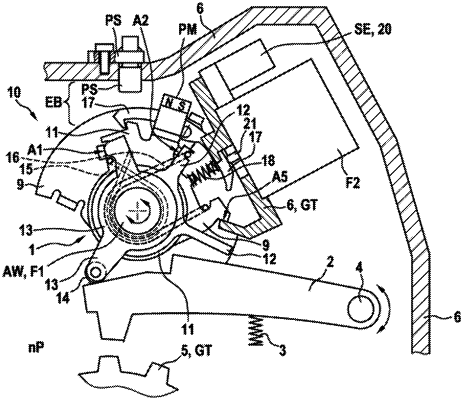| CPC F16H 63/3491 (2013.01) [F16H 63/3466 (2013.01); F16H 63/3475 (2013.01)] | 12 Claims |

|
1. A parking lock device (10) for a vehicle transmission (GT), comprising:
a drive shaft (AW) and a first actuator (F1), by which the drive shaft (AW) can be rotated;
a locking pawl (2), which can be latched into the vehicle transmission (GT) with a locking effect;
a rotary mechanism (1), which is connected to the drive shaft (AW) and comprises a latching mechanism (17, 18), an engagement spring (16) and a permanent magnet (PM), wherein the locking pawl (2) and the rotary mechanism (1) can be moved with the permanent magnet (PM) between a locking position (P) and a neutral position (nP) for the vehicle transmission (GT), wherein the rotary mechanism (1) can be preloaded by the engagement spring (16) and, as a result, the neutral position (nP) can be adopted; wherein the parking lock device (10) further comprises:
a second actuator (F2), by which the latching mechanism can be triggered when the engagement spring (16) is preloaded and, as a result, the locking position (P) can be selected by a force effect of the engagement spring (16) on the rotary mechanism (1), wherein, when the engagement spring (16) is preloaded, the rotary mechanism (1) can be held in the neutral position (nP) by the engaged latching mechanism, and wherein the first actuator is furthermore designed to move the rotary mechanism (1) and thereby load the engagement spring (16) again and, after that, to move the rotary mechanism (1) into the neutral position (nP);
a position sensor (PS), which is arranged in a detection region (EB) of the permanent magnet (PM), wherein the position sensor (PS) is configured to detect a movement of the permanent magnet (PM) relative to the position sensor (PS) and thereby to ascertain whether the locking pawl (2) is in the locking position (P) or in the neutral position (nP) on account of the rotary mechanism (1); and
a control device (SE), which is connected to the position sensor (PS) and to the first actuator (F1) and to the second actuator (F2), and which is configured to control operation of the first actuator (F1) and/or of the second actuator (F2).
|